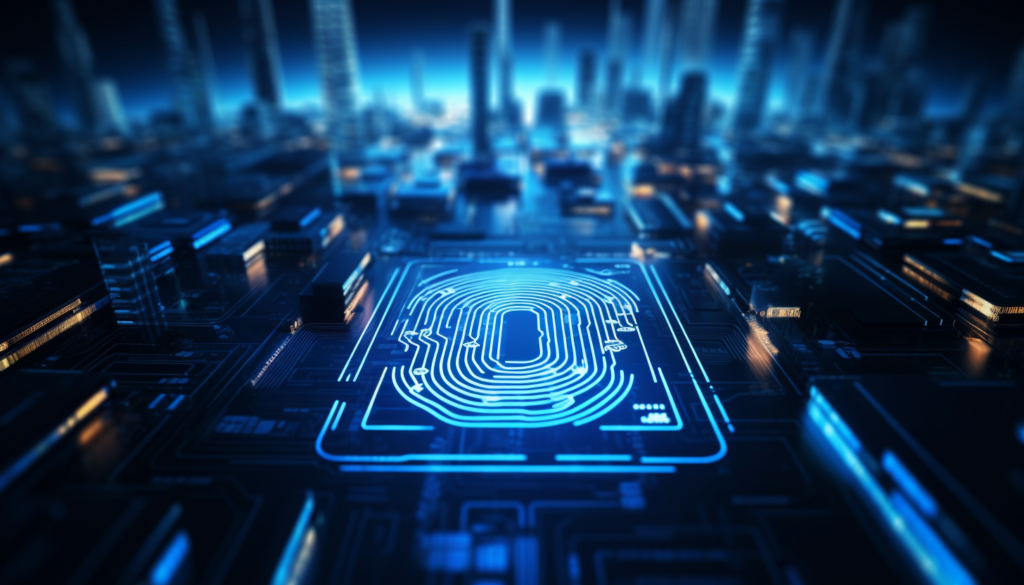STAYING A STEP AHEAD WITH PROACTIVE DARK WEB MONITORING

Dark Web Monitoring is a tool that helps keep you safe online. It scans hidden parts of the internet that most people can’t access, looking for signs that your personal information is being sold or shared illegally.
In simple terms, the dark web is a hidden area on the internet where people often engage in illegal activities.
This is where information stolen from data breaches, like credit card or Social Security numbers, usually ends up.
Monitoring this area can help you protect your identity and keep your data secure.
What is the Dark Web, Deep Web and Surface Web?
The terms “Dark Web,” “Deep Web,” and “Surface Web” refer to different layers of the internet, each serving different purposes and having varying levels of accessibility and content.
Here’s a breakdown:
Surface Web
The Surface Web is what most people think of when they hear “the internet.” It consists of all the web pages indexed by search engines like Google, Yahoo, and Bing.
This is where you find websites like Wikipedia, YouTube, and social media platforms. Everything is publicly accessible, and you don’t need any special tools to browse these sites.
Deep Web
The Deep Web is a larger portion of the internet that is not indexed by standard search engines. This doesn’t mean the content is illegal or harmful; it just isn’t accessible via conventional means.
Examples include academic databases, private data repositories, password-protected websites, personal email accounts, and other types of data that are not meant for public consumption.
You might access parts of the Deep Web every day without realizing it, like when you check your online banking account.
Dark Web
The Dark Web is a small, encrypted part of the Deep Web that operates without oversight by authorities or standard internet protocols.
This makes it a haven for illegal activities, although not everything on the Dark Web is illicit. To access the Dark Web, special software such as Tor or I2P is usually required.
Here, you can find marketplaces selling illegal goods like drugs or weapons, forums discussing illegal activities, but also forums for whistle-blowers, journalists, and people living under oppressive regimes to communicate securely.
Each layer has its own risks and benefits, but understanding the differences can help you navigate the internet more safely and efficiently.

Understanding Dark Web Threats
The Dark Web is a hotbed for various threats. These include identity theft, where personal information is stolen and used fraudulently; financial fraud, involving credit card information or bank details; and data breaches, where sensitive data is leaked without authorization.
There are countless examples of data breaches and cybercrimes originating from the Dark Web. The infamous Equifax data breach in 2017 saw the personal details of 147 million people exposed.
Another example is the 2016 LinkedIn data breach, where 167 million account details were stolen and later sold on the Dark Web.
Dark Web monitoring
Dark Web monitoring can help detect these threats early, allowing for swift action to mitigate potential damage. It’s a proactive approach to cybersecurity that every business should consider.
Monitoring the dark web can provide early warnings if your personal or business data has been compromised.
It’s about being proactive, staying one step ahead of the cybercriminals.
If your data appears on the dark web, swift action can be taken to protect your identity and assets.
In essence, Dark Web Monitoring acts as an early warning system, alerting you to potential threats before they escalate into full-blown crises.
It’s not just about protection; it’s about peace of mind in an increasingly digital world.
So, don’t wait until it’s too late! Equip yourself with Dark Web Monitoring and keep your valuable information out of the wrong hands.

Benefits of Dark Web Monitoring
Dark Web Monitoring acts as your digital guardian, tirelessly scanning these obscure parts of the internet for any signs of your sensitive data.
If your information, such as credit card details or social security numbers, lands in these areas, it could be bought and sold by cybercriminals.
With Dark Web Monitoring, you have an extra layer of protection that keeps an eye out for these threats.
Real-time alerts and proactive measures
One of the standout features of Dark Web Monitoring is its real-time alert system. The moment it detects your data on the Dark Web, you receive an instant notification.
This allows you to take immediate action to mitigate potential damage. Additionally, it offers proactive measures to prevent future breaches, helping to secure your digital presence.
Here’s a quick glance at the benefits:
| Benefit | Explanation |
|---|---|
| Protects individuals and businesses | – Acts as a digital guardian: Scans the dark web for any signs of your sensitive data. – Provides an extra layer of protection: Keeps an eye out for threats to your personal or business information. |
| Real-time alerts and proactive measures | – Instant notification: Alerts you the moment it detects your data on the dark web. – Allows immediate action: Helps you mitigate potential damage quickly.- Offers proactive measures: Helps prevent future breaches and secure your digital presence. |
Dark Web Monitoring Tool
Dark Web monitoring tools are designed to proactively scan, identify, and alert organizations or individuals when their sensitive data or information appears on the Dark Web.
These tools can help prevent or mitigate the damage caused by data breaches, identity theft, and other cyber threats. Here are some key features and examples of such tools:
Key Features:
1. Data Breach Alerts: Real-time alerts when your sensitive data like email addresses, passwords, and financial information appears on the Dark Web.
2. Keyword Monitoring: Allows you to specify keywords, such as brand names or specific document titles, to monitor for unauthorized use or distribution.
3. Identity Monitoring: Scans the Dark Web for personal identifiers like Social Security numbers, driver’s license numbers, or passport details.
4. Competitor Intelligence: Some tools also provide data on competitors, giving insight into market activity.
5. Compliance Reporting: Generates reports detailing Dark Web exposure, useful for compliance with data protection laws like GDPR, CCPA, etc.
6. User-Friendly Dashboard: Easy-to-use interface for non-technical users to understand the threats and exposures.
Examples of Dark Web Monitoring Tools:
1. Recorded Future: Provides threat intelligence by monitoring the Dark Web and other online sources.
2. Experian IdentityWorks: Offers Dark Web surveillance as part of its identity theft protection services.
3. DigitalStakeout: Provides a wide range of social media, domain, and Dark Web monitoring services.
4. Terbium Labs’ Matchlight: Focuses on data fingerprinting to quickly identify data breaches and leaks.
5. IntSights: Offers threat intelligence tailored to your specific industry and digital assets, including Dark Web monitoring.
6. Cyberint: Focuses on protecting digital businesses by monitoring various threat landscapes, including the Dark Web.
Dark Web monitoring is especially beneficial for businesses that store large volumes of sensitive data, as well as individuals who want to ensure their personal information remains secure.

Popular Dark Web Monitoring Services
Dark Web Monitoring is a must-have service in today’s digital age. It’s a proactive defense strategy that keeps an eye on the shadowy corners of the internet, alerting individuals or businesses if their sensitive data appears on the Dark Web.
Overview of top Dark Web monitoring services
1. LifeLock: A renowned name in identity theft protection, LifeLock offers comprehensive Dark Web monitoring as part of its service package.
2. Experian: Besides credit monitoring, Experian also provides Dark Web surveillance, scanning thousands of websites, forums, and other data points.
3. IDShield: IDShield’s Dark Web intelligence leverages advanced technology to monitor and alert users about compromised personal information.
Features and pricing comparison
While all three services offer robust Dark Web monitoring, they differ in features and pricing. LifeLock provides reimbursement for stolen funds, Experian offers credit score tracking, and IDShield provides consultation services. When it comes to pricing, LifeLock and Experian are more premium, while IDShield is a budget-friendly option.
Here’s a comparison table:
| Service | Key Features | Pricing |
|---|---|---|
| LifeLock | Dark Web Monitoring, Stolen Funds Reimbursement | Premium |
| Experian | Dark Web Monitoring, Credit Score Tracking | Premium |
| IDShield | Dark Web Monitoring, Consultation Services | Budget-friendly |
Remember, the best service depends on individual needs and budget. Make sure to do due diligence before making a choice.
Setting Up Dark Web Monitoring for Personal or Business Use
Step 1: Choose a reputable Dark Web monitoring service. Look for one that offers comprehensive coverage, including scanning forums, black markets, and other hidden sites.
Step 2: Register for the service. This typically involves providing some basic information and choosing a subscription plan.
Step 3: Set up your account. Most services will guide you through this process. You’ll need to input the data you want to monitor, such as email addresses, credit card numbers, or Social Security numbers.
Step 4: Activate monitoring. Once your account is set up, the service will start scanning the Dark Web for your data.
Step 5: Stay informed. If your data appears on the Dark Web, the service will alert you so you can take immediate action.
With these steps, you are now ready to take control of your digital security and protect yourself from potential threats lurking in the shadows of the Dark Web!
Interpreting Dark Web Monitoring Results
Dark web monitoring services are designed to scan, identify, and notify individuals or businesses when their personal or proprietary information appears on the dark web.
These services can provide valuable insights into what data may be at risk and where it has been exposed.
The information provided by these services can range from email addresses and passwords to social security numbers and credit card details.
Taking action against compromised data
Once you receive an alert about compromised data, it’s time to spring into action. Changing passwords, alerting financial institutions, or even contacting law enforcement can be necessary steps.
In some cases, you might need to consider credit monitoring or identity theft protection services.
Remember, knowledge is power! By understanding your dark web monitoring results, you can take swift action to protect your personal information and prevent further damage.
Here’s a quick breakdown of how dark web monitoring works:
| Steps | Description |
|---|---|
| Understand the Information | Dark web monitoring services scan the dark web for your personal or proprietary information and alert you if anything is found. |
| Take Action | Once alerted, you need to take immediate action. This could include changing passwords, notifying banks or credit card companies, or even contacting law enforcement. |

Best Practices for Dark Web Protection
Stay Vigilant: Regularly monitor your digital footprint. This includes keeping an eye on your bank accounts, credit reports, and any suspicious activity related to your personal information.
Avoid Sharing Personal Information: Be cautious about the information you share online. Cybercriminals can use seemingly harmless details to piece together your identity.
Strong Passwords: Use complex passwords that are hard to guess. Consider using a password manager to keep track of them all.
Two-Factor Authentication: Enable two-factor authentication whenever possible. This adds an extra layer of security to your accounts.
Dark Web Monitoring Services: Consider subscribing to a Dark Web monitoring service. These services scan the Dark Web for your personal information and alert you if they find it being traded or sold.
By following these best practices, you can significantly decrease your risk of falling victim to Dark Web threats.
Real-life examples of individuals or businesses affected by Dark Web activities
Individuals:
1. Identity Theft: Personal information is often sold on the Dark Web. In 2015, the U.S. Office of Personnel Management (OPM) was hacked, exposing the personal data of 22 million people, which later found its way to the Dark Web.
2. Cyberstalking and Harassment: Some individuals have been victims of cyberstalking campaigns organized through the Dark Web. Victims often don’t know they’re being targeted until it’s too late.
3. Illegal Drug Sales: Silk Road was a notorious marketplace for the sale of drugs, weapons, and other illegal items. Ross Ulbricht, its founder, was arrested and sentenced to life imprisonment.
Businesses:
1, Data Breaches: Companies like Equifax and Target have had their customer data sold on the Dark Web after massive breaches.
2, Ransomware Attacks: WannaCry and NotPetya ransomware attacks were facilitated through malware kits available on the Dark Web. These attacks had devastating impacts on hospitals, shipping companies, and other businesses.
3. Corporate Espionage: Sensitive corporate data, including patents and trade secrets, can be bought and sold on the Dark Web. In 2017, Veritas Pharmaceuticals had its proprietary drug formulas stolen and sold online.
4. Fraudulent Activities: In 2019, the Wall Street Market was shut down, a Dark Web platform where stolen credit card information, among other illicit items, were sold.

Lessons learned and preventive measures
Dark Web Monitoring: Businesses and individuals can proactively protect themselves with Dark Web Monitoring This service scans, identifies, and notifies when your personal or business information appears on the Dark Web.
Data Protection: Regularly updating security software, using strong passwords, and educating employees about phishing scams can help prevent data breaches.
Remember, prevention is always better than cure. Stay vigilant and protect your data from falling into the wrong hands on the Dark Web.
Conclusion – Proactive Dark Web Monitoring
In the cyber realm, the dark web is a notorious space where cybercriminals lurk, trading stolen data and launching attacks. Dark Web Monitoring is a powerful tool in the arsenal of cybersecurity, designed to keep an eye on this murky underworld.
Dark Web Monitoring is not a one-time event. It’s an ongoing process that requires vigilance and constant updates to stay ahead of cyber threats. It’s like having a security guard who never sleeps, always on the lookout for threats to your digital assets.
Moreover, maintaining cybersecurity awareness is equally crucial. It’s about staying informed about the latest threats and understanding how to protect yourself and your business from them.
This combination of continuous monitoring and awareness can significantly reduce the risk of falling prey to cyber-attacks.
FAQ (Frequently Asked Questions)
What is Dark Web Monitoring?
Dark Web Monitoring involves scouring the depths of the dark web to detect if your personal or business information has been compromised and is being traded illegally.
Why is maintaining cybersecurity awareness important?
Cybersecurity awareness helps individuals and businesses understand the potential threats they face online. It empowers them with knowledge to safeguard their digital assets effectively.
Remember, in today’s digital age, cybersecurity is not an option but a necessity!
Secure Your Business Today
Don’t leave your business vulnerable to cyber threats. Click below to discover custom cybersecurity solutions designed to protect your unique needs. With Cyb-Uranus, robust security is just a click away

